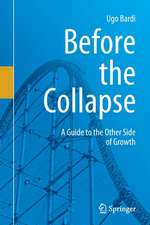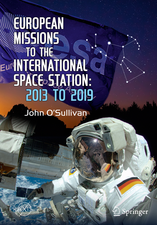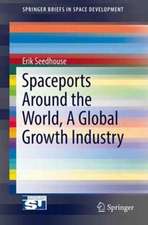Mars via the Moon: The Next Giant Leap: Springer Praxis Books
Autor Erik Seedhouseen Limba Engleză Paperback – 15 dec 2015
The time has come for commercial enterprise to lead the way back to the lunar surface. Embarking on such a venture requires little in the way of new technologies. We don’t need to develop super-fast propulsion systems like those required to get us to Mars safely, nor do we need hundreds of billions of dollars that the experts reckon it will cost to transport humans to the Red Planet. What we do need is a place to test the technologies and deep space experience that will enable us to build a pathway that will lead us to Mars. That place is the Moon and this book explains why.
Din seria Springer Praxis Books
-
 Preț: 294.46 lei
Preț: 294.46 lei -
 Preț: 223.45 lei
Preț: 223.45 lei -
 Preț: 193.12 lei
Preț: 193.12 lei -
 Preț: 167.85 lei
Preț: 167.85 lei -
 Preț: 288.98 lei
Preț: 288.98 lei -
 Preț: 323.74 lei
Preț: 323.74 lei -
 Preț: 401.38 lei
Preț: 401.38 lei -
 Preț: 264.12 lei
Preț: 264.12 lei - 8%
 Preț: 513.00 lei
Preț: 513.00 lei -
 Preț: 190.01 lei
Preț: 190.01 lei -
 Preț: 218.16 lei
Preț: 218.16 lei -
 Preț: 312.06 lei
Preț: 312.06 lei - 17%
 Preț: 414.04 lei
Preț: 414.04 lei -
 Preț: 216.41 lei
Preț: 216.41 lei -
 Preț: 262.27 lei
Preț: 262.27 lei -
 Preț: 264.35 lei
Preț: 264.35 lei -
 Preț: 167.63 lei
Preț: 167.63 lei -
 Preț: 284.81 lei
Preț: 284.81 lei -
 Preț: 259.08 lei
Preț: 259.08 lei -
 Preț: 305.47 lei
Preț: 305.47 lei -
 Preț: 244.14 lei
Preț: 244.14 lei -
 Preț: 227.85 lei
Preț: 227.85 lei -
 Preț: 285.25 lei
Preț: 285.25 lei -
 Preț: 295.56 lei
Preț: 295.56 lei -
 Preț: 357.17 lei
Preț: 357.17 lei -
 Preț: 275.79 lei
Preț: 275.79 lei -
 Preț: 257.08 lei
Preț: 257.08 lei -
 Preț: 349.71 lei
Preț: 349.71 lei -
 Preț: 272.45 lei
Preț: 272.45 lei -
 Preț: 270.27 lei
Preț: 270.27 lei - 8%
 Preț: 456.51 lei
Preț: 456.51 lei -
 Preț: 352.34 lei
Preț: 352.34 lei - 8%
 Preț: 394.80 lei
Preț: 394.80 lei -
 Preț: 320.65 lei
Preț: 320.65 lei -
 Preț: 325.29 lei
Preț: 325.29 lei -
 Preț: 253.11 lei
Preț: 253.11 lei -
 Preț: 192.86 lei
Preț: 192.86 lei -
 Preț: 313.40 lei
Preț: 313.40 lei -
 Preț: 150.51 lei
Preț: 150.51 lei -
 Preț: 233.34 lei
Preț: 233.34 lei -
 Preț: 286.78 lei
Preț: 286.78 lei -
 Preț: 212.01 lei
Preț: 212.01 lei -
 Preț: 366.83 lei
Preț: 366.83 lei -
 Preț: 299.99 lei
Preț: 299.99 lei -
 Preț: 232.27 lei
Preț: 232.27 lei -
 Preț: 284.58 lei
Preț: 284.58 lei -
 Preț: 212.45 lei
Preț: 212.45 lei -
 Preț: 159.81 lei
Preț: 159.81 lei -
 Preț: 349.48 lei
Preț: 349.48 lei - 20%
 Preț: 2061.61 lei
Preț: 2061.61 lei
Preț: 245.66 lei
Nou
Puncte Express: 368
Preț estimativ în valută:
47.01€ • 49.08$ • 38.90£
47.01€ • 49.08$ • 38.90£
Carte tipărită la comandă
Livrare economică 01-07 aprilie
Preluare comenzi: 021 569.72.76
Specificații
ISBN-13: 9783319218878
ISBN-10: 3319218875
Pagini: 250
Ilustrații: XX, 170 p. 80 illus. in color.
Dimensiuni: 168 x 240 x 10 mm
Greutate: 0.44 kg
Ediția:1st ed. 2016
Editura: Springer International Publishing
Colecția Springer
Seriile Springer Praxis Books, Space Exploration
Locul publicării:Cham, Switzerland
ISBN-10: 3319218875
Pagini: 250
Ilustrații: XX, 170 p. 80 illus. in color.
Dimensiuni: 168 x 240 x 10 mm
Greutate: 0.44 kg
Ediția:1st ed. 2016
Editura: Springer International Publishing
Colecția Springer
Seriile Springer Praxis Books, Space Exploration
Locul publicării:Cham, Switzerland
Public țintă
Popular/generalCuprins
Martian Mission Killers.- Government Anchors.- Commercial Anchors.- Technology.- The Human Element: Missions.- Regulation.- Headwinds and Tailwinds.- Making the Business Case.
Recenzii
“Mars via the Moon is the author’s twentieth book. Attractively illustrated and priced, I found it to be thoughtful and intriguing.” (Richard McKim, The Observatory, Vol. 136 (1254), October, 2016)
“Seedhouse presents the case of using the Moon as a technological stepping-stone to an eventual mission to Mars. … Mars via the Moon effectively, if briefly, outlines the key issues with respect to space explorers once again leaving low-Earth orbit for more ambitious goals. It supports the premise of using the Moon as the best means of proving the technology, identifying sustainable industry, and addressing the long-term physiological and perhaps psychological limitations of humans before attempting a mission to Mars.” (Anthony Young, The Space Review, the spacereview.com, January 2016)
“Seedhouse presents the case of using the Moon as a technological stepping-stone to an eventual mission to Mars. … Mars via the Moon effectively, if briefly, outlines the key issues with respect to space explorers once again leaving low-Earth orbit for more ambitious goals. It supports the premise of using the Moon as the best means of proving the technology, identifying sustainable industry, and addressing the long-term physiological and perhaps psychological limitations of humans before attempting a mission to Mars.” (Anthony Young, The Space Review, the spacereview.com, January 2016)
Notă biografică
Dr. Erik Seedhouse is a research scientist specializing in environmental life sciences and physiology, the subject in which he obtained his Ph.D. while working for the European Space Agency between 1996 and 1998. In 2009, he was one of the final candidates for selection as an astronaut in the CSA’s Astronaut Recruitment Campaign. He is a certified commercial suborbital astronaut and is the Canadian Payload Broker for XCOR via Arête. Between 2008-13 he was Director of Canada's Manned Centrifuge and Hypobaric Chamber Operations. He is a spaceflight instructor for the American Astronautics Institute/Project PoSSUM and the Training Director for Astronauts for Hire. He works as manned spaceflight consultant, triathlon coach, author and public speaker. He is currently co-authoring a book with Franklin Chang-Díaz on the subject of VASIMR and teaching commercial astronauts in Melbourne, Florida, which is where he'd like to spend much more time.
Textul de pe ultima copertă
MOMENTUM IS BUILDING for a return to the Moon. NASA’s international partners on the International Space Station are in favor of returning to the lunar surface, as are India and China. The horizon goal may be Mars, but the political, funding and the technological and medical infeasibility of such an objective means the next logical step is a return to the Moon. While much has been learned about the Moon over the years, we don’t understand its resource wealth potential and the technologies to exploit those resources have yet to be developed, but there are a number of companies that are developing these capabilities. And, with the discovery of water in the lunar polar regions, plans are in the works to exploit these resources for fuel for transportation operations in cis-lunar space and in low Earth orbit (LEO).
The time has come for commercial enterprise to lead the way back to the lunar surface. Embarking on such a venture requires little in the way of new technologies. We don’t need to develop super-fast propulsion systems like those required to get us to Mars safely, nor do we need hundreds of billions of dollars that the experts reckon it will cost to transport humans to the Red Planet. What we do need is a place to test the technologies and deep space experience that will enable us to build a pathway that will lead us to Mars. That place is the Moon and this book explains why.
OMENTUM IS BUILDING for a return to the Moon. NASA’s international partners on the International Space Station are in favor of returning to the lunar surface, as are India and China. The horizon goal may be Mars, but the political, funding and the technological and
medical infeasibility of such an objective means the next logical step is a return to the Moon. While much has been learned about the Moon over the years, we don’t understand its resource wealth potential and the technologies to exploit those resources have yet to be developed, but there are a number ofcompanies that are developing these capabilities. And, with the discovery of water in the lunar polar regions, plans are in the works to exploit these resources for fuel for transportation operations in cis-lunar space and in low Earth orbit (LEO). The time has come for commercial enterprise to lead the way back to the lunar surface. Embarking on such a venture requires little in the way of new technologies. We don’t need to develop super-fast propulsion systems like those required to get us to Mars safely, nor do we need hundreds of billions of dollars that the experts reckon it will cost to transport humans to the Red Planet. What we do need is a place to test the technologies and deep space experience that will enable us to build a pathway that will lead us to Mars. That place is the Moon and this book explains why.
The time has come for commercial enterprise to lead the way back to the lunar surface. Embarking on such a venture requires little in the way of new technologies. We don’t need to develop super-fast propulsion systems like those required to get us to Mars safely, nor do we need hundreds of billions of dollars that the experts reckon it will cost to transport humans to the Red Planet. What we do need is a place to test the technologies and deep space experience that will enable us to build a pathway that will lead us to Mars. That place is the Moon and this book explains why.
OMENTUM IS BUILDING for a return to the Moon. NASA’s international partners on the International Space Station are in favor of returning to the lunar surface, as are India and China. The horizon goal may be Mars, but the political, funding and the technological and
medical infeasibility of such an objective means the next logical step is a return to the Moon. While much has been learned about the Moon over the years, we don’t understand its resource wealth potential and the technologies to exploit those resources have yet to be developed, but there are a number ofcompanies that are developing these capabilities. And, with the discovery of water in the lunar polar regions, plans are in the works to exploit these resources for fuel for transportation operations in cis-lunar space and in low Earth orbit (LEO). The time has come for commercial enterprise to lead the way back to the lunar surface. Embarking on such a venture requires little in the way of new technologies. We don’t need to develop super-fast propulsion systems like those required to get us to Mars safely, nor do we need hundreds of billions of dollars that the experts reckon it will cost to transport humans to the Red Planet. What we do need is a place to test the technologies and deep space experience that will enable us to build a pathway that will lead us to Mars. That place is the Moon and this book explains why.
Caracteristici
Makes a strong case for returning to the Moon as the next logical and vital step in space exploration Explains how a Moon-Mars alliance can be created to develop lunar industrial bases both on and around the Moon and how these bases will make a Mars mission more viable and realizable Explores ways the lunar and Mars missions can become more attractive for industry investment



















